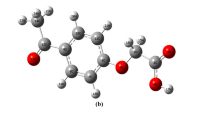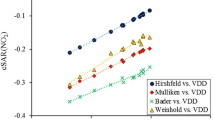Abstract
A quantum-topological analysis of the electron density calculated by the density functional theory method in the B3LYP/6-31G(d,p) approximation was performed to determine and quantitatively characterize four types of noncovalent interactions in mono-and disubstituted 4-aminophenoxy-and 4-carboxyphenoxycyclotriphosphazenes P3N3Cl5OC6H4NH2, P3N3Cl4(OC6H4NH2)2, P3N3Cl5OC6H4COOH, and P3N3Cl4(OC6H4COOH)2. These are C-H…N hydrogen bonds between a nitrogen atom of the phosphazene ring and a hydrogen atom of the benzene ring, C-H…C interactions between a carbon atom of one phenoxy group and a hydrogen atom of the other such group (C-H…π interactions), N-H…N interactions between nitrogen and hydrogen atoms of neighboring amino groups, and C-O…C interactions between oxygen atoms of neighboring carboxyl groups. This system of noncovalent bonding interactions determines the mutual orientation of oxyphenyl fragments. The total energy of interatomic contacts estimated from the local potential energy of electrons at the corresponding critical bond points is larger for the amino than for the carboxyl group. It follows that the amino group has the strongest effect on the mutual orientation of oxyphenyl fragments. The effect of the carboxyl group is weaker.
Similar content being viewed by others
References
H. R. Allcock, Phosphorus-Nitrogen Compounds: Cyclic, Linear, and High Polymeric Systems (Academic, New York, 1972; Mir, Moscow, 1976).
H. R. Allcock, D. C. Ngo, and M. Parvez, J. Am. Chem. Soc. 113, 2628 (1991).
V. Chandrasekhar and S. Nagenran, Chem. Soc. Rev. 30, 193 (2001).
H. R. Allcock, P. E. Austin, and T. F. Rakowsky, Macromolecules 14, 1622 (1981).
D. Alekperov, T. Shirosaki, T. Sakurai, et al., Polymer J. 35(5), 417 (2003).
D. Alekperov, T. Shirosaki, T. Sakurai, et al., Polymer Prepn. Jpn. 51(14), 3611 (2002).
G. Popova, V. Kireev, A. Spitsyn, et al., Mol. Cryst. Liq. Cryst. 390, 91 (2003).
M. A. Vantsyan, M. F. Bobrov, G. V. Popova, et al., Vysokomol. Soedin., Ser. A 49(3), 533 (2007) [Polymer Science, Ser. A 49 (3), 355 (2007)].
M. F. Bobrov, G. V. Popova, and V. G. Tsirel’son, Zh. Fiz. Khim. 82(8), 1458 (2008).
R. F. Bader, Atoms in Molecules: A Quantum Theory, Vol. 22 of International Series of Monographs on Chemistry (Clarendon, Oxford, U.K., 1990; Mir, Moscow, 2001).
A. A. Granovsky, http://classic.chem.msu.su/gran/gamess/index.html.
M. W. Schmidt and K. K. Baldridge, J. A. Boatz, et al., J. Comput. Chem. 14, 1347 (1993).
F. W. Biegler-Konig, R. F. W. Bader, and T.-H. Tang, J. Comput. Chem. 3, 317 (1982).
M. F. Bobrov and M. V. Yakovlev, in Advances in Chemistry and Chemical Technology, (Ross. Khim.-Tekhnol. Univ. im. D. I. Mendeleeva, Moscow, 2000), Vol. 14, Part 3, p. 61 [in Russian].
H. Sabzyan and Z. Kalantar, J. Mol. Struct. (Theochem) 663, 149 (2003).
M. Breza, J. Mol. Struct. (Theochem) 505, 169 (2000).
A. M. Pendas, A. Costales, and V. J. Luana, Phys. Chem. 102, 6937 (1998).
V. Luana, A. M. Pendas, A. Costales, et al., J. Phys. Chem. 105, 5280 (2001).
M. F. Bobrov, G. V. Popova, and V. G. Tsirel’son, Zh. Fiz. Khim. 80(2), 682 (2006) [Russ. J. Phys. Chem. 80 (4), 584 (2006)].
T. Steiner, J. Chem. Soc., Chem. Commun., p. 95 (1995).
G. R. Desiraju, Acc. Chem. Res. 29, 441 (1996).
J. J. Novoa and F. Mota, Chem. Phys. Lett. 318(4–5), 345 (2000).
T. Steiner, Angew. Chem., Int. Ed. Engl. 41, 76 (2002).
D. B. DuPre, J. Phys. Chem. A 109(4), 622 (2005).
E. A. Zhurova, V. G. Tsirelson, A. I. Stash, and A. A. Pinkerton, J. Am. Chem. Soc. 124, 4574 (2002).
A. H. Pakiari and K. Eskandari, J. Mol. Struct. (Theochem) 806, 1 (2007).
T. M. Klapotke, P. Mayer, A. Schulz, and J. J. Weigand, J. Am. Chem. Soc. 127(7), 2032 (2005).
E. Espinosa, I. Alkorta, I. Rozas, et al., Chem. Phys. Lett. 336(5–6), 457 (2001).
Author information
Authors and Affiliations
Corresponding author
Additional information
Original Russian Text © M.F. Bobrov, V.G. Tsirel’son, 2008, published in Zhurnal Fizicheskoi Khimii, 2008, Vol. 82, No. 12, pp. 2332–2340.
Rights and permissions
About this article
Cite this article
Bobrov, M.F., Tsirel’son, V.G. The role played by the amino and carboxyl groups in the formation of the geometric and electronic structure of phenoxy substituted cyclophosphazenes. Russ. J. Phys. Chem. 82, 2103–2110 (2008). https://doi.org/10.1134/S0036024408120236
Received:
Published:
Issue Date:
DOI: https://doi.org/10.1134/S0036024408120236




